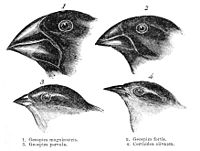
Photo from wikipedia
Conventional wheat-breeding programs involve crossing parental lines and subsequent selfing of the offspring for several generations to obtain inbred lines. Such a breeding program takes more than 8 years to… Click to show full abstract
Conventional wheat-breeding programs involve crossing parental lines and subsequent selfing of the offspring for several generations to obtain inbred lines. Such a breeding program takes more than 8 years to develop a variety. Although wheat-breeding programs have been running for many years, genetic gain has been limited. However, the use of genomic information as selection criterion can increase selection accuracy and that would contribute to increased genetic gain. The main objective of this study was to quantify the increase in genetic gain by implementing genomic selection in traditional wheat-breeding programs. In addition, we investigated the effect of genetic correlation between different traits on genetic gain. A stochastic simulation was used to evaluate wheat-breeding programs that run simultaneously for 25 years with phenotypic or genomic selection. Genetic gain and genetic variance of wheat-breeding program based on phenotypes was compared to the one with genomic selection. Genetic gain from the wheat-breeding program based on genomic estimated breeding values (GEBVs) has tripled compared to phenotypic selection. Genomic selection is a promising strategy for improving genetic gain in wheat-breeding programs.
Journal Title: Frontiers in Genetics
Year Published: 2020
Link to full text (if available)
Share on Social Media: Sign Up to like & get
recommendations!